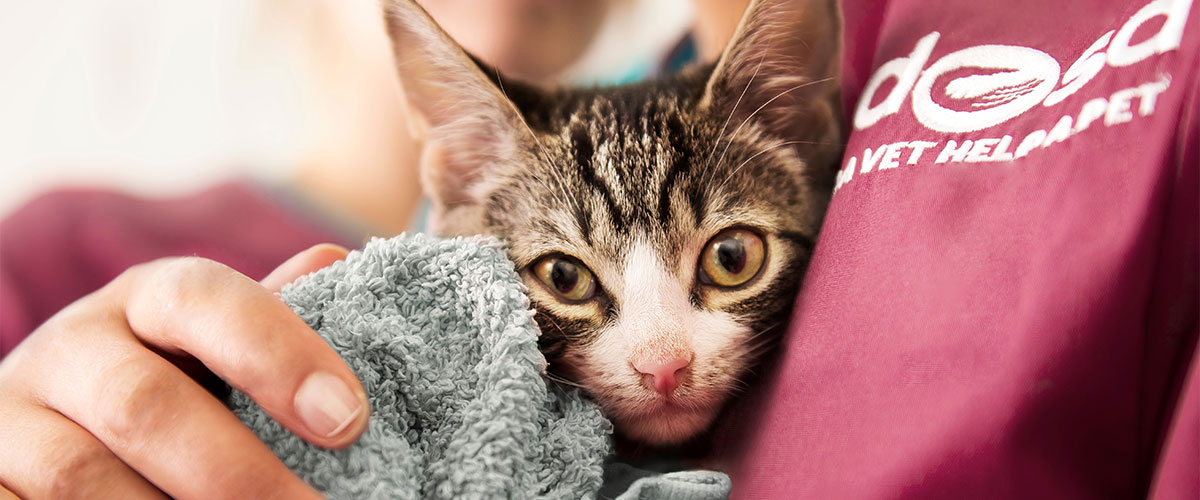A balanced diet is vital for your cat’s health. Cats are carnivores (meat eaters) because they require specific nutrients found in meat such as Taurine and Arginine. Without these nutrients they are at risk of severe health problems such as heart disease and blindness.
It’s also important to feed your cat the right amount of food to prevent obesity-linked problems such as diabetes and arthritis. Regularly weighing your cat will help you spot quickly if they're putting on any weight, so you can adjust their diet as needed.
What should I feed my cat?
Cats are ‘obligate carnivores’, which in simple terms, means they need to eat meat to get all the nutrients they require to stay healthy (such as Taurine and Arginine). Without these vital nutrients they are at risk of becoming extremely ill. Thankfully, most commercial cat foods contain all the nutrients a cat needs. There are many different cat foods available, so here are our top tips to help you figure out what to look for when selecting one:
- Complete: Always feed your cat food that’s labelled ‘complete’ – this means it has all the nutrients they need. If it’s labelled ‘complementary’ this means it should only be given occasionally as a treat.
- Commercially made: We advise buying a commercial cat food rather than making your own at home. Although it is possible to make a balanced cat diet at home, it’s incredibly difficult to get the nutrient balance right. Browse our specially selected range of vet-approved cat food in the PDSA Pet Store.
- Member of ‘UK Pet Food’: Make sure you choose a food made by a member of ‘UK Pet Food’. All foods produced by members of this organisation are made with the highest level of safety, quality, and nutritional standards.
- Life stage appropriate: It’s important to feed your cat the right food for their current stage of life e.g. kitten, adult, or senior. Read the section on ‘life stage feeding’ below for more information.
- Wet or dry: Unless your vet has said otherwise, your cat can have wet food, dry food, or a combination of the two. If you feed a combination, you’ll just need to make sure that you’re giving them the right amount by looking at the packets and working out their portion sizes. It’s worth pointing out that feeding a wet diet can increase your cat’s water intake if they’re not keen on drinking.
- Flavours: There are a variety of cat food flavours and textures. Some cats prefer to stick to the same food every day, whereas others enjoy a variety. It doesn’t matter what flavours and textures you choose as long as your feline friend is happy.
Life stage feeding
It’s important to feed your cat the right diet for their age, because as they get older, their requirement for vitamins, minerals, energy, protein and fat, will change. Thankfully, most commercial cat food companies have done the hard work for us, so all you need to do is select the right food.
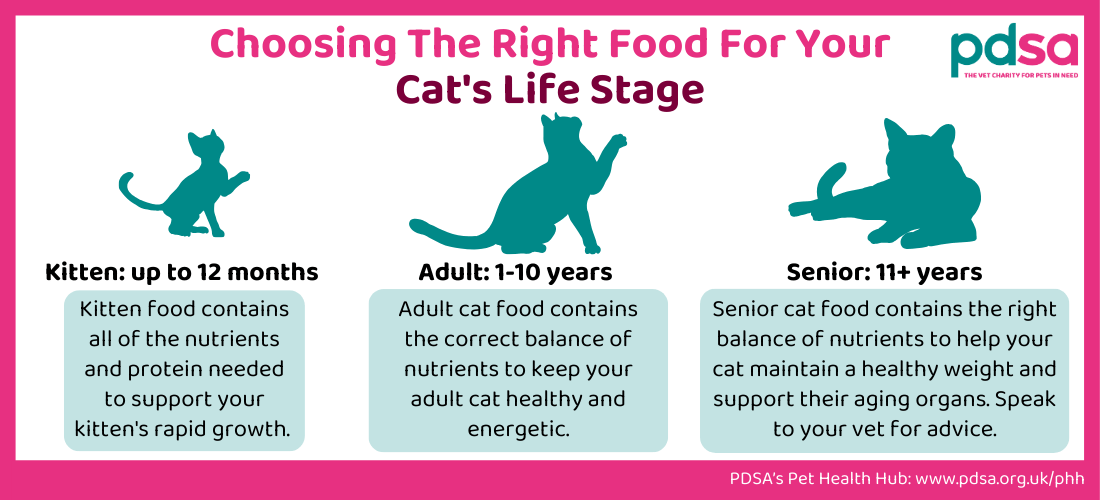
Feeding your kitten
- Cats are kittens for their first year of life. During this time, it’s important that they are fed a food specifically for kittens, containing the correct balance of nutrients for their growing bones and body.
- Most kittens start to eat food (other than milk) from about three weeks of age. Their first food should be soft and easy to digest and will be supplemented by their mother’s milk. Young kittens need lots of small meals to keep their energy levels stable throughout the day.
- When your kitten is ready to come home with you, which is usually around eight to twelve weeks, continue with the same food they have been getting so far to help to avoid stomach upsets. If you decide to change them to a new diet once they have settled, introduce it gradually to them.
- Over the next few months, the number of meals your kitten has can gradually be reduced. Some will be happy to have two meals a day by the time they are six months old, but most cats prefer constant access to their food so they can graze on small amounts whenever they feel hungry.
Feeding an adult cat
- A cat is considered adult from one to ten years old.
- There are many types of adult cat food designed for different lifestyles. For example, food for indoor cats, food for cats that are neutered, and food for cats that need to lose weight.
- If your cat has a medical condition, they may require a special prescription diet from your vet.
- Consult your vet if you’re not sure which food is right for your cat.
Feeding a senior cat
- Cats are considered to have reached their senior years once they are around eleven years old.
- There are some parts of a cat’s diet that become harder to process as they get older, such as salt. The altered ingredients in senior cat food will help support your cat’s organs, such as their kidneys, as well as helping them maintain weight and muscle.
- It’s really important to monitor older cats closely to check how much they’re eating and drinking each day. If they start eating less or drinking more it could be a symptom of a health problem such as kidney disease, dental problems or diabetes. Be sure to contact your vet if you’re worried and need advice.
How should I feed my cat?
Lots of cats prefer to ‘graze’ throughout the day instead of being restricted to meal times. Most cats are good at knowing how much they need to eat, but some will keep asking for more so it’s a good idea to weigh out your cat’s portion at the start of the day. If your cat eats all of their daily allowance in one go and begs for more, it may be better to feed them two meals a day, splitting their daily allowance in half.
Here are some of our tips for feeding your cat:
- Choose shallow bowls. Cats prefer these as they can see around them as they eat and drink. Shallow bowls also prevent their whiskers from brushing against the side of the bowl.
- Choose bowls which are easy to clean, such as ceramic bowls. Buy separate food and water bowls and have an extra of each, because cats are happier with choice! Avoid plastic bowls. They are harder to clean and can build up food odour over time which can put a cat off its food.
- Always keep food and water bowls well away from litter as (understandably) cats don’t like to eat next to their toilet.
- Some cats prefer to have their water and food bowls kept apart.
- Your cat will need constant access to fresh, clean water from a clean bowl.
Changing your cat’s food
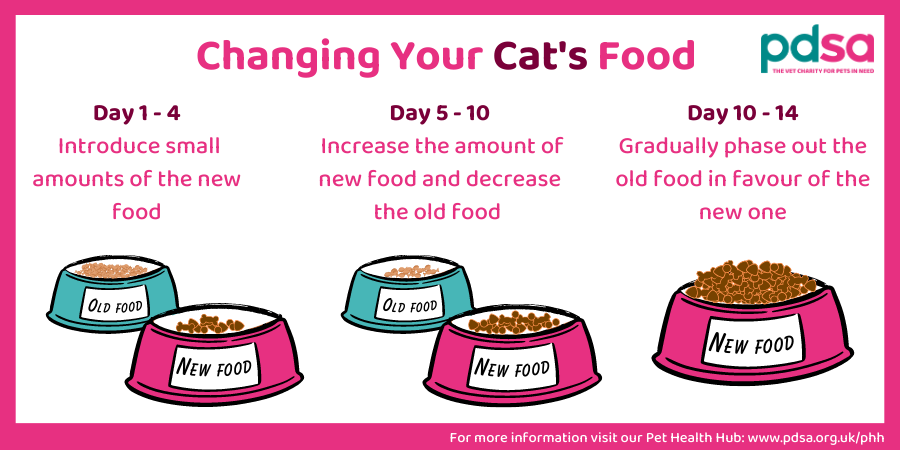
If you need to change your cat’s food, you’ll need to introduce the new food over a couple of weeks to avoid them developing a stomach upset, or refusing to eat. Never change their food suddenly unless you are advised to do so by your vet. Here are some simple steps to help your cat adjust to new food:
- Introduce small amounts of the new food (Day 1-4): Give your cat their regular meal but add a small teaspoonful of their new food on a separate plate or bowl. Do not mix the foods together as you’ll just want to introduce them to their new food. Be patient and only move on to the next step if your cat has happily eaten the new food for at least three days.
- Increase the amount of new food and decrease the old food (Day 5-10): By day five, start increasing the amount of new food and decrease the old food. Keep the food separate at all times as texture is very important to cats. If you mix the food, they might not eat any of it. The whole change-over process might take longer than ten days for some cats - don’t be tempted to skip ahead as your cat may reject the food completely.
- Gradually phase out the old food (Day 10-14): After your pet is eating the new food consistently alongside the old one for at least a week, start feeding only the new food. If they don’t want to eat it, this is usually a sign that the process has been too quick, and you’ll need to start again. If they still won’t eat their new food, try swapping to another flavour, texture, or brand.
Picking healthy treats for your cat
Although cats don’t need anything other than a complete diet to meet their nutritional needs, it’s fine for them to enjoy the occasional treat as long as they don’t have too many, and they aren’t too high in fat:
- Stick to healthy treats, such as:
- Cooked white fish
- Cooked chicken breast
- Cooked turkey breast
- Safe fruit and vegetables (see below)
- On the days you feed your cat treats, reduce their main meals accordingly so they don’t gain weight.
- Stick to a small number and don’t let treats exceed 10-15% of your cat’s daily calorie allowance. Any more and your cat may not get enough of their normal food to receive all the nutrients they need.
- Avoid high fat treats, milk (many cats are lactose intolerant), and raw meat (raw meat can transmit infectious diseases such as toxoplasmosis).
- Many shop bought cat treats are high in calories, so avoid giving too many of these.
Can my cat eat fruit and vegetables?
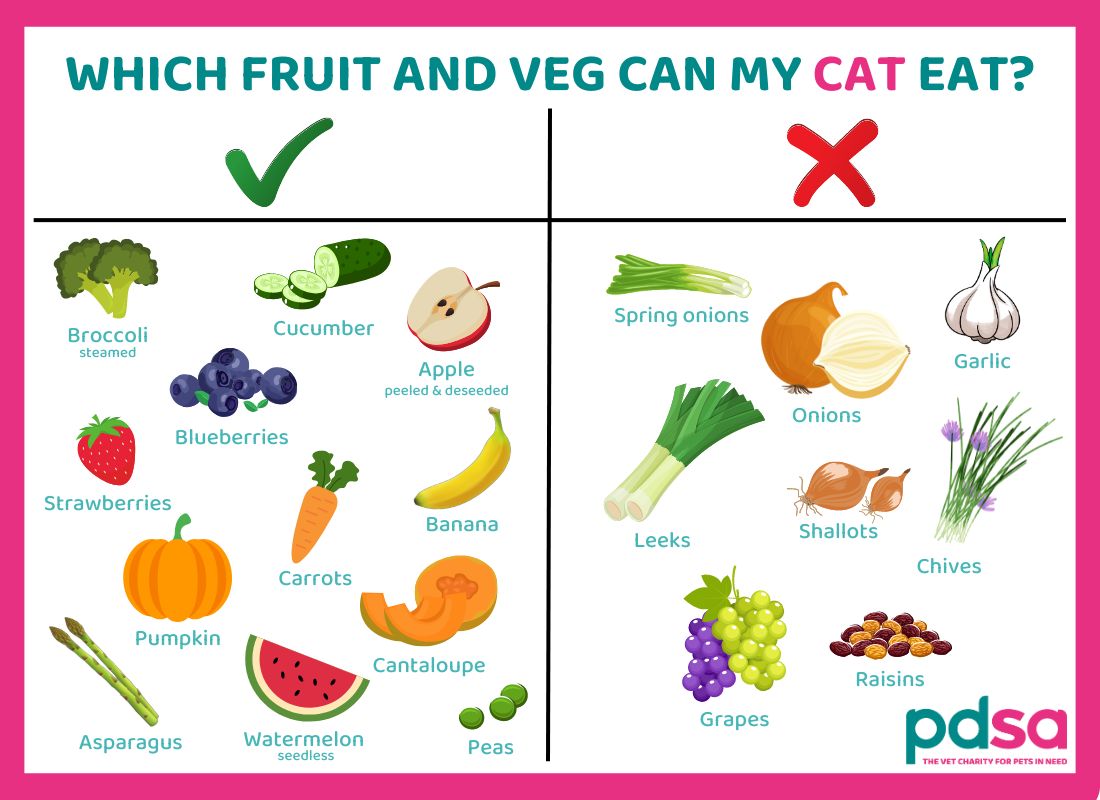
Cats don’t need fruit or vegetables as part of their diet, but many can be given in very small quantities as an occasional treat. Just remember not to give them too much, make sure whatever you give is in bite-sized pieces, and remove any seeds to avoid choking. Take a look at our list of safe fruit and vegetables below:
- Cucumber
- Pumpkin
- Broccoli (in very small amounts as large quantities can cause illness)
- Carrots
- Asparagus
- Peas
- Bananas
- Strawberries
- Blueberries
- Melon (deseeded)
- Watermelon (deseeded)
- Apples (deseeded)
There are quite a few unsafe fruit and vegetables that can cause potential harm to your cat if ingested. If you think that your cat may have eaten something harmful, speak to your vet or Animal PoisonLine for advice. Here are a few examples of fruit and vegetables to avoid giving to your cat:
- Grapes
- Raisins
- Garlic
- Onions
- Chives
- Leeks
- Shallots
- Scallions
- Mouldy food waste
If your cat is struggling with their weight already or has a medical condition that requires a specific diet, it’s best to avoid feeding extra food treats altogether. Instead, you can find other ways to ‘treat’ them. Why not try playing a game or spending time with them, instead? You can also put aside a small portion of their regular food to use in a puzzle feeder or during training – this is a great way to encourage your cat to exercise their mind as well as their body.
- Can I give milk to my cat as a treat?
- Can I feed my cat a vegetarian/vegan diet?
- Can I feed my cat a raw diet?
Can I give milk to my cat as a treat?
It’s best not to give your cat cow’s milk as a treat because it contains lactose, which many cats struggle to digest – causing an upset tummy. Cream and dairy products are also high in fat so will contribute to your cat piling on the pounds. You can buy ‘cat milk’ for your cat, which doesn’t contain lactose, but this is still high in calories and doesn’t contain any nutrients that your cat won’t be getting in their compete diet.
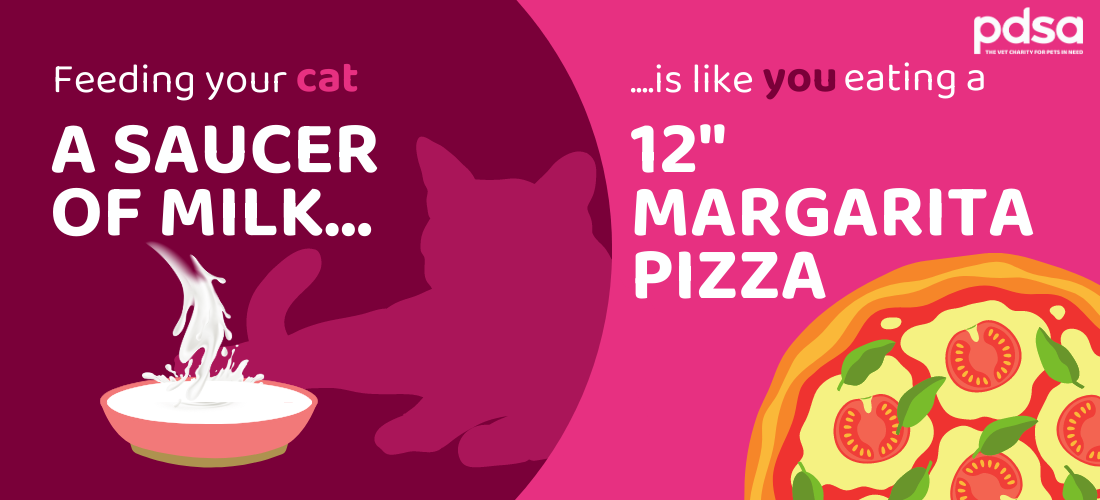
Can I feed my cat a vegetarian/vegan diet?
If you’re not a meat eater yourself, it’s understandable that you might find it hard to feed your cat meat. However, it’s very difficult for cats to remain healthy on a vegetarian or vegan diet. There are some vegetarian and vegan cat foods available commercially - but before you start feeding them, it’s vitally important to ensure your cat will be getting all the right nutrients, so speak to your vet beforehand.
Can I feed my cat a raw diet?
A raw cat diet can provide all the nutrients your cat needs - but does also increase the risk of them catching certain diseases. If you do decide to feed a raw diet to your cat, be sure to sure to choose a commercially prepared, complete raw diet.
Some of the diseases caused by raw diets can be passed to humans – so be sure to have strict food hygiene and contact the NHS for advice if you’re worried about yourself or someone you know after being in contact with raw food. Read our full advice on raw diets.
Published January 2024
This article was written by PDSA vets and nurses, in conjunction with Animal PoisonLine - www.animalpoisonline.co.uk

